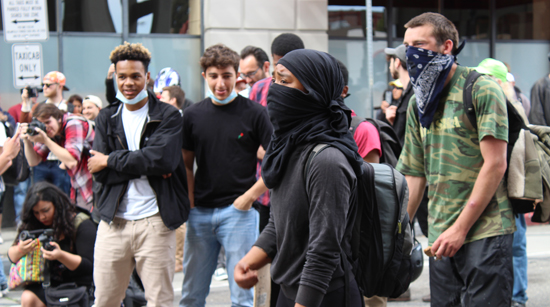Accepting and Responding to Crisis
UAlbany Researchers Outline Strategies for Presidents to Guide a Campus Through Emergencies
 |
|
Protests on college campuses, such as those at Berkeley in April of 2017, can cause stress, but they also present learning opportunities for leadership. (Photo by Kevin Jenco, Wikimedia Commons)
|
ALBANY, N.Y. (October 18, 2017) – Demonstrators shut down conservative speakers at Berkeley; a student opens fire in a classroom at Virginia Tech; an alleged brutal assault at Virginia makes international headlines before the story collapses. Each incident poses a distinct threat to the university, both in terms of physical and reputational damage, but each incident also offers an opportunity for college leaders to learn how to best guide their institution through turmoil, according to a new paper by University at Albany communications experts Eric K. Stern and Joseph Brennan.
In "Leading a campus through crisis: The role of college and university presidents," recently published in the Journal of Education Advancement & Marketing, Stern and Brennan look at the role of presidents in crisis leadership, and how it is distinct from operational management.
"In the age of rapid information sharing, the role of presidents in leading college campuses through turmoil has never been more important," said Stern, a professor in the College of Emergency Preparedness, Homeland Security and Cybersecurity at UAlbany. "But with proper preparedness, university leaders are uniquely positioned to guide their institutions through – and back from – a period of crisis."
 |
|
Stern and Brennan see crisis leadership as critically important to managing college turmoil.
|
Stern and Brennan point out that while many universities have emergency management plans in place in the event of an incident, they often miss a key element: the preparation of presidents and other policy-level officers of the university to perform their roles in a crisis.
"Crisis leadership requires not only making decisions, but also communicating them in ways that help to maintain a president’s – and an organization’s – legitimacy and credibility," said Brennan, the vice president for Communications and Marketing at UAlbany and a clinical professor in the School of Business. "Crises often come with opportunities as well as threats, and effective leadership is a key element in managing not only the incident but the reputational impact it entails."
Brennan and Stern identify six distinct but related tasks that comprise crisis leadership:
- Preparing, which deals with creating pre-conditions and dispositions which facilitate collaborative effort as well as effective and legitimate intervention when crises occur;
- Sense-making in crisis refers to the challenging task of developing an adequate interpretation of what are often complex, dynamic, and ambiguous situations;
- Decision-making refers to the fact that crises tend to be experienced by leaders (and those who follow them) as a series of ‘what do we do now’ problems triggered by the flow of events;
- Meaning-making, which refers to the fact that leaders must attend not only to the operational challenges associated with a contingency, but also to the ways in which various stakeholders and constituencies perceive and understand it;
- Terminating, the non-trivial task of finding the appropriate timing and means to end the crisis, manage accountability processes and return to normalcy; and
- Learning, which requires an active, critical process that documents, recreates, analyzes and evaluates key processes, tactics, techniques and procedures in order to enhance performance, safety, capabilities and other key indicators.
The stakes are high: failure to perform the role of crisis leadership adequately can lead to widespread loss of confidence in these leaders and grave damage to the university’s image and brand, argue the authors.
And University leaders who fail to rise to the occasion risk losing legitimacy and credibility among on- and off-campus stakeholders to such a degree that they may be removed from office, such as the case of former University of Missouri President Tom Wolfe and Chancellor R. Bowen Loftin, who were forced to resign following a wave of racially-charged student protests.
![]() For more news, subscribe to UAlbany's RSS headline feeds
For more news, subscribe to UAlbany's RSS headline feeds
A comprehensive public research university, the University at Albany-SUNY offers more than 120 undergraduate majors and minors and 125 master's, doctoral and graduate certificate programs. UAlbany is a leader among all New York State colleges and universities in such diverse fields as atmospheric and environmental sciences, business, education, public health,health sciences, criminal justice, emergency preparedness, engineering and applied sciences, informatics, public administration, social welfare and sociology, taught by an extensive roster of faculty experts. It also offers expanded academic and research opportunities for students through an affiliation with Albany Law School. With a curriculum enhanced by 600 study-abroad opportunities, UAlbany launches great careers.


